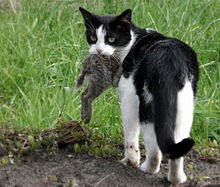Most feral cats have small home ranges, although some are more transient and travel long distances. The home ranges of male feral cats, which are generally two or three times larger than those of female cats, are on average under 10 ha (25 acres or 0.0390625 ), but can vary from almost 300 ha (740 acres or 1.15625 square miles) to under 1 ha (2.5 acres or 12100 square yards).
When Bella (or as my neighbours whom she adopted call her "Tallulah") moved into the garden it was her territory and she would not go far and fought any cat or fox that encroached. Once settled in her house home next door she had a bigger area and will now go a couple houses further along. So she was dumped, looked after in my garden then became semi (and I mean semi) domesticated when she moved into next door's house.
Bella has caught pigeons -the ladies next door take them from her to fly another day- she will play with slow worms, kill rats and mice and if she got a chance would kill smaller birds. However, she is well fed these days!
Back in 1999 Margaret Roberts, then Chief Veterinarian for the Cats Protection League noted that feral cats are accused of killing birds and wild life but in fact, rather like city foxes, lived nearer to humans and spources of regular food put out by house holders whether for hedgehogs, foxes or even the cats themselves.
Feral cats living outside cities and towns or even in old industrial estates tend to live on mice, rats and birds though as I have observed a number of house cats eat moths, butterflies and other insects these are no doubt also on the menu. Rabbits are also going to be a food source.
Again, like the fox, feral AND domestic cats (though I have observed domestic cats within two feet of rats and have no idea what they should do!) keep down the rat and mouse populations effectively -which is why up until the 1980s most factories and some shops had resident "Ratter" or "Mouser" cats -the one at Poples Popular Pies/butchers in the 1960s also got its full of beetles and cockroaches.
Again, Roberts pointed out what is basic fact but tends to be deliberately ignored: there is a prey-predator ration. Plenty of food sources then the cats will breed well but there is an auto shut off point when prey are scarce and young could not be fed. Hence the differing territories. No rats or mice -go to the houses where food is put out.
It was noted early on in the study of non native cats that opportunities for food -it used to be when meat was discarded in bins after Christmas at one point- were taken as presented. Foxes featured on the menu in the countryside -observed.
This means that in assessing territories for feral cats and even hybrid cats (domestic-F. silvestris) has to be based on the same information asked in "big cat" reports: What is the area like -golf courses, woods or semi-urban; are there wild rabbits or wild fowl -there is a long list but it tells you whether it is likely that a large cat is living in an area or moving through. Along with cat territories I noted the researchers at Swansea University noted others and even found a golden cat "nest" area.
This means that if we have a new population of hybrid feral cats and the reports are widespread then it has to mean to total population is large. The so called "Hooper Cats" (this name was used by Police Forces Wildlife Crimes Officers) I am preparing a paper on, do appear to be wide spread but future field studies will be needed and that requires the setting up of trail cameras as well as relying on people around the country just interested in helping out.
Once the paper has been published the project will be more widely publicised but any and all help in the meantime is welcome.
Terry Hooper-Scharf
Feral & Hybrid Study Project
Vale Wildlife Group







No comments:
Post a Comment